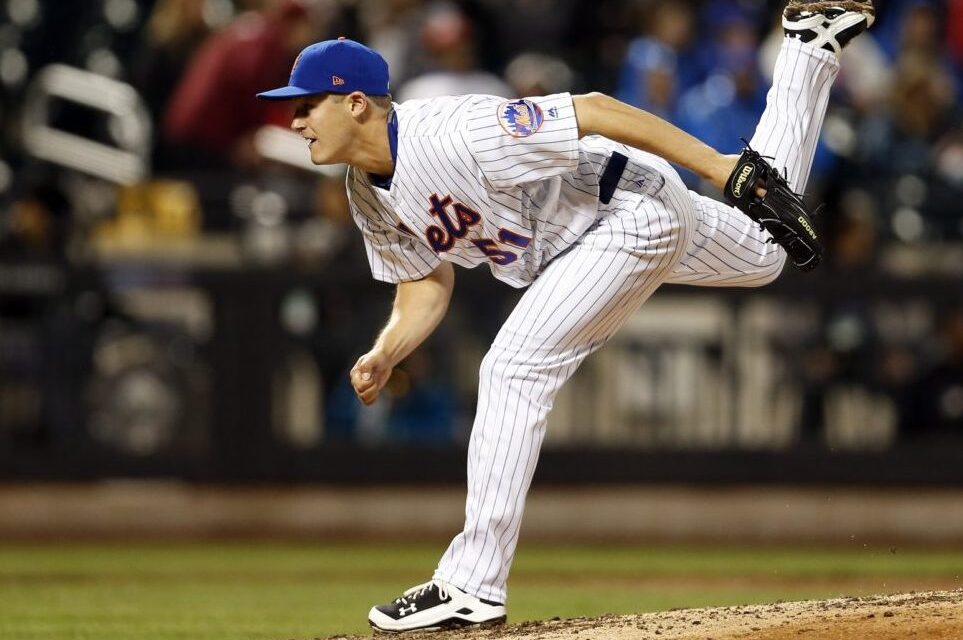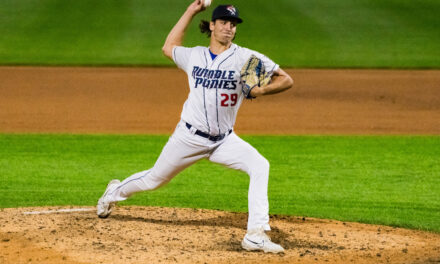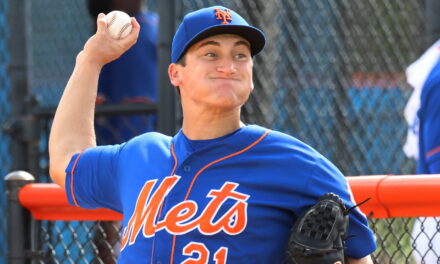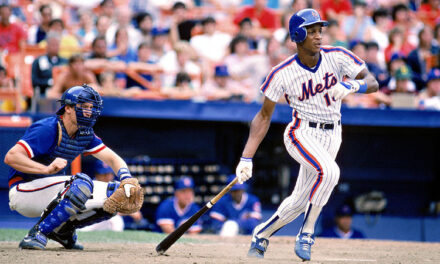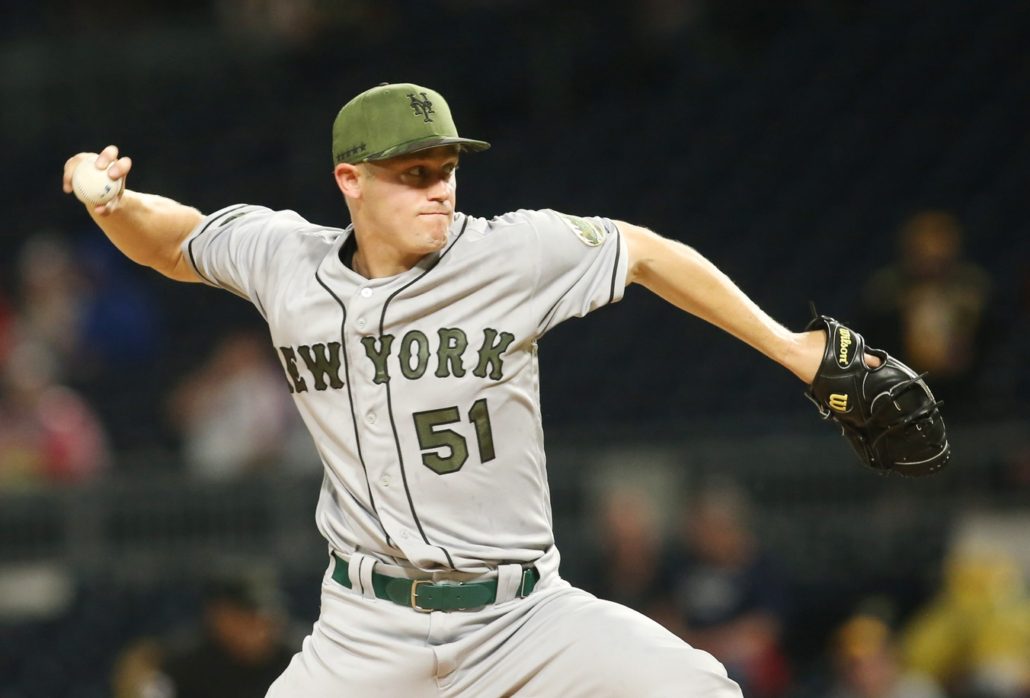
Paul Sewald entered spring training with a chip on his shoulder.
After pitching to a 3.29 ERA in 56 games with the Las Vegas 51s in 2016, Sewald had hoped that his impressive stats in the hitters’ paradise – otherwise known as the Pacific Coast League -would warrant a major league call-up.
The phone never rang for Sewald. Instead, he posted career highs in games (56), innings pitched (65.2) and strikeouts (80) with the 51s.
While the Mets decided against calling up the right-hander out of the University of San Diego, they did include him on the list of non-roster invitees to major league spring training for the second straight year. The then 26-year-old, former tenth-round draft pick, made a strong impression on the club’s brass, pitching in 11 games for 14.1 innings (the most among Mets’ relievers), holding opponents to a .143 batting average with an ERA of 2.51 and a WHIP of 0.84 (5th best among Mets’ pitchers with minimum five innings pitched).
As the roster was being trimmed to 25, Sewald was one of the final players cut, reassigned to minor league camp and eventually found his way back to Las Vegas to open the 2017 season.
The 51s’ season opened on April 6th, an 8-1 defeat to El Paso. Sewald entered in the 8th, working around a leadoff walk to then promptly strike out the side over his next 10 pitches. He was simply picking up where he left off from his impressive spring showing.
Just one day later, after making his season debut, Sewald would finally receive the long-awaited phone call he had hoped to hear in 2016.
You’re heading to the majors.
The Mets were in need of a fresh arm, having relied heavily upon the relief contingent in the first four games of the season, and decided to add an eighth arm to the pen. Sewald made his major league debut on Saturday, April 8th against the Miami Marlins, just a half-day removed from getting the call-up in El Paso. Three straight singles followed by a bunt groundout allowed two runs to score in just a third of an inning for Sewald in his debut before Terry Collins brought in Jerry Blevins for the final two outs in the eighth inning.
The rookie right-hander admits that it probably would’ve been in his best interest to have gotten a full 24-hours of acclimating himself to the majors before being thrust into action. However, Sewald got redemption against the Marlins in a May 7th game, where he was tasked with giving the Mets depth after starter Adam Wilk served up six runs (five earned) in only 3.2 innings.
Sewald tossed 3.1 innings, allowing a run on four hits, with six strikeouts and no walks, a game he reflects back on with pride.
It was then that Sewald felt a certain level of confidence, having just handled a strong Marlins’ lineup that featured Marcell Ozuna, Christian Yelich and Giancarlo Stanton. Sewald felt more relaxed following that outing and it showed; as he posted a 1.42 ERA over his next nine outings in the month of May.
With the Mets decimated by injuries and underperformance this season, the front office called up many of Sewald’s teammates from Las Vegas, giving them a good look as to who could be possible contributing fits in 2018 and beyond. Sewald made the most of his opportunity, appearing in 57 games (12th-most among all rookie relievers in 2017), pitching to a 4.55 ERA, though, his 3.74 FIP captured a better picture of his contributions on the year.
His impressive strikeout totals from the minors translated into his rookie season with the team, averaging 9.5 strikeouts-per-nine, all while relying on a low 90s fastball and low 80s slider. Sewald uses deception and an above-average spin rate on his four-seamer to throw off hitters, allowing him added confidence to throw his fastball in any count.
I had the privilege of speaking with Sewald at the end of October, where we discussed his spring success, major league call-up, and his bullpen sessions with Hall of Fame starter Greg Maddux.
MMO: You pitched extremely well in spring training this past season, as you were one of the final cuts of the spring. Did you have any thoughts that you might head north with the Mets to start the season?
Paul: I went into spring training just wanting to show them what I can do, kind of with a chip on my shoulder [for] not getting called up the year before. I didn’t expect anything crazy, but I just wanted to show them that maybe at some point they would try and call me up during the year. Then I had such a good year and I made it pretty much through the last day [of spring training], and I started to get a little antsy. Thinking, Familia’s suspended, maybe I do have a chance at the Opening Day roster while he’s not going to be around?
Then I got cut and I’m sitting there trying to figure out when I could get called up now. I’m thinking maybe at best it could be a September call-up type of thing. Then the next thing I know, I’m called up two days into the Triple-A season and it worked out.
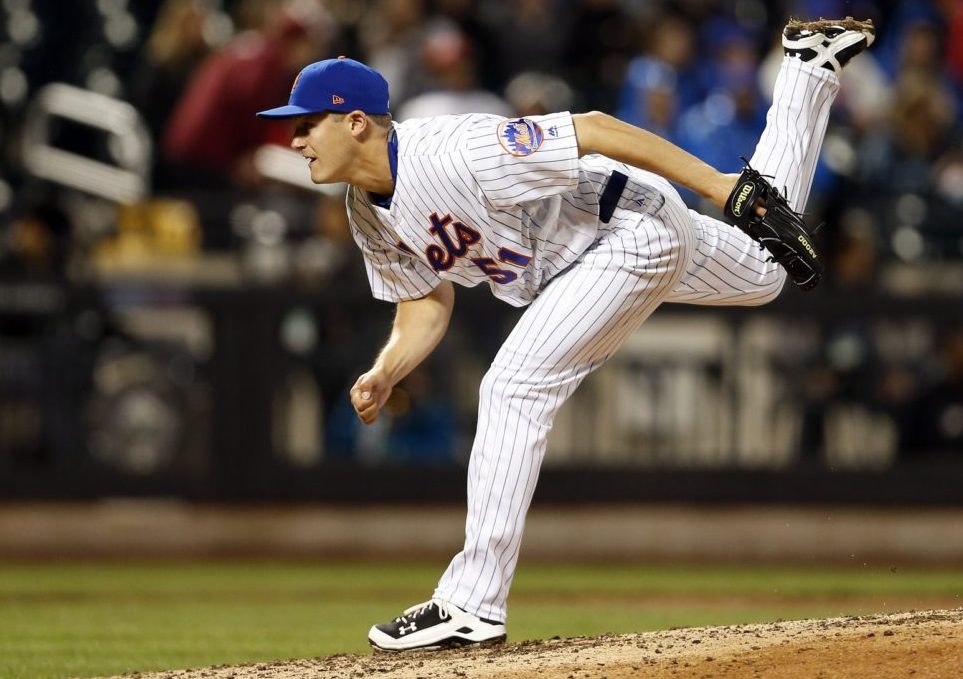
MMO: Can you talk about the moment you found out that you were being called up to the Mets?
Paul: We were in El Paso and they called me on the bullpen phone and said, “Sewald needs to come down to the dugout,” which I was kind of confused about. Honestly, it was two days into the season, it hadn’t even occurred to me that they would be calling me up right away. I didn’t really get it until I came into the dugout, and [manager] Pedro Lopez told me.
It was incredible, obviously.
MMO: Who did you tell the news to first?
Paul: Fiancé was the first call, parents were the second call and brother was my third call. Then it started to get a little crazy, so I kind of started to wait a little bit. I made sure my agent knew right away and then it was nuts, that’s for sure!
MMO: April 8th, your major league debut. What stands out from that day and game for you?
Paul: It was loud. Beggars can’t be choosers, I know, but I definitely would’ve liked to have probably been there for 24-hours. Gotten a night’s sleep, that probably would’ve been better for my first outing. My mind was racing; I was barely in control of anything, so it was crazy.
Looking back, I wouldn’t trade it for the world. One bad outing in your debut is not that big of a deal. The experience was incredible.
MMO: Were there any particular adjustments that you made when you were optioned back to Las Vegas in mid-April?
Paul: No, not really. I got called up so early into the season, I had only pitched once and I didn’t even feel like I was necessarily in a groove when I got called up. So then I went down for two weeks and got in six or seven games and kind of got to get myself into the middle of the season, which is where you start to get into a rhythm and everything like that.
I felt like a was throwing a ton of strikes, making good pitches, and I got called up at a perfect time feeling good about how I was throwing.
MMO: I’ve read that you take great interest in the new analytics in baseball. Is that something that’s always fascinated you? Is this something you look to incorporate into your overall game?
Paul: I wouldn’t say always. I would say, like most people that have baseball backgrounds, I was a little skeptical of how exactly you could use it, or, how it was best to put it into action.
T.J. [Barra] gave me a write up at the end of last year, and I hadn’t really thought about why maybe I could get away with the fastball when others don’t, other than I have a little bit of deception. Then you look and your spin rate’s above average and it kind of gives a little bit of an explanation.
I kind of use it as a confidence booster knowing maybe it’s not 95-96, but my 91-93 is better than a regular 91-93. Give yourself the confidence that you have a plus fastball because you’re not going out there throwing regular 91 mph fastballs. They’re moving a little bit, I have some deception, [and] they have a little bit of spin rate.
It gave me a lot of confidence that way.
MMO: So, T.J. Barra was the first to pass along the spin rate stats to you?
Paul: Yeah, he was the first guy who sent them to the pitching coordinator, Ron Romanick, and he sent it to me. I just looked at it and I was trying to just match up why I have so much success, other than I’ve always been confident about myself. That gives me a little bit of a reason for it.
It was different. Growing up, I was always not a hard thrower and I got a lot of ground balls. I got to professional baseball and I stopped getting ground balls, but I kept pitching well so I didn’t really know why. I didn’t do anything differently. It’s just one of those things, I guess.
MMO: Those numbers must help solidify your confidence, as it helps you to realize the advantages you hold over other pitchers who don’t have the high spin rate.
Paul: It just gives me a little bit of confidence that I might not have had. Facing major league hitters, just because I get behind in the count, doesn’t mean I can’t throw a fastball and I have to be scared of these guys. It has to be well executed if I’m behind in the count, but I can throw a fastball, even if they know a fastball’s coming. If I locate it I’m going to be fine.
It gives me the ability not to be scared at any time when I’m pitching which is, you don’t want that bad feeling, you just want to go out there and throw quality strikes and that should be the only thing on your mind.
MMO: You’re a guy that’s had a considerable amount of success pitching in Las Vegas. What are those conditions like for a pitcher? And what are some of the things you look to work on knowing you’re not pitching in a pitcher’s league?
Paul: It is tough, it is tough. A lot of guys are going up there feeling really confident because you’re in very hitter-friendly parks. Your off-speed doesn’t move quite as much, it’s not really that sharp. There are a lot of things going against pitchers. At the same time, maybe your stats aren’t going to be as good as they would be if you were in a pitcher’s league, but it comes down to still throwing good pitches and locating my fastball were the most important things. I had to get people out with my fastball, learn to get people out with my fastball, and I think I can.
You can also take their aggressiveness in that league against them a little bit easier than you can maybe in the major leagues. A lot of guys are going up there swinging, so if you get to two strikes, a lot of the time, you can get an easy strikeout because guys aren’t choking up and trying to put it in play and avoid the strikeout. Most of the time it’s going up there trying to blast one out of the park from the first pitch on. So you can use it against them a little bit.
MMO: You’ve gotten to throw bullpens in front of Hall of Fame starter, Greg Maddux. How was that arranged, and can you talk a bit about some of the conversations you shared with him?
Paul: He’s the pitching coach at the University of Nevada, Las Vegas. We go over there and throw our bullpens before the season, and I did so a couple of times before I went to winter ball. It was just me and another kid and so we got a lot of two-on-one time with Greg, which was pretty incredible. He has so much knowledge and he just wants to teach, teach and teach.
He had six or seven things in my bullpen and I was like, ‘Okay, here’s the thing; some of us can only process maybe one or two things at a time. I know you were different than everybody else, but give me one thing to focus on, two things to focus on because I have to limit my ability to focus on something during a bullpen.’
It was pretty cool. I didn’t throw any sliders because I was just trying to work on fastball/change at the time. He said, “Your changeup is your best off-speed pitch, right?”
I told him, ‘No, I think I maybe throw it five percent of the time.’
And he was like, “What do you mean?”
I said, ‘My slider’s my best pitch for sure. That’s my strikeout pitch, that’s my go-to. I rarely throw a changeup.’
This is before I got to the big leagues where I had to throw it a little bit more. I was just like no, I really just get people out with a fastball/slider. He had a lot of confidence in it [changeup] and if he thinks it’s good, why don’t I think it’s as good as he does?
He gave me a lot of confidence and I just need to go out there and try it and use my changeup a little more. Even if I’m not as confident in it because if he thinks it’s good then it’s obviously pretty decent.
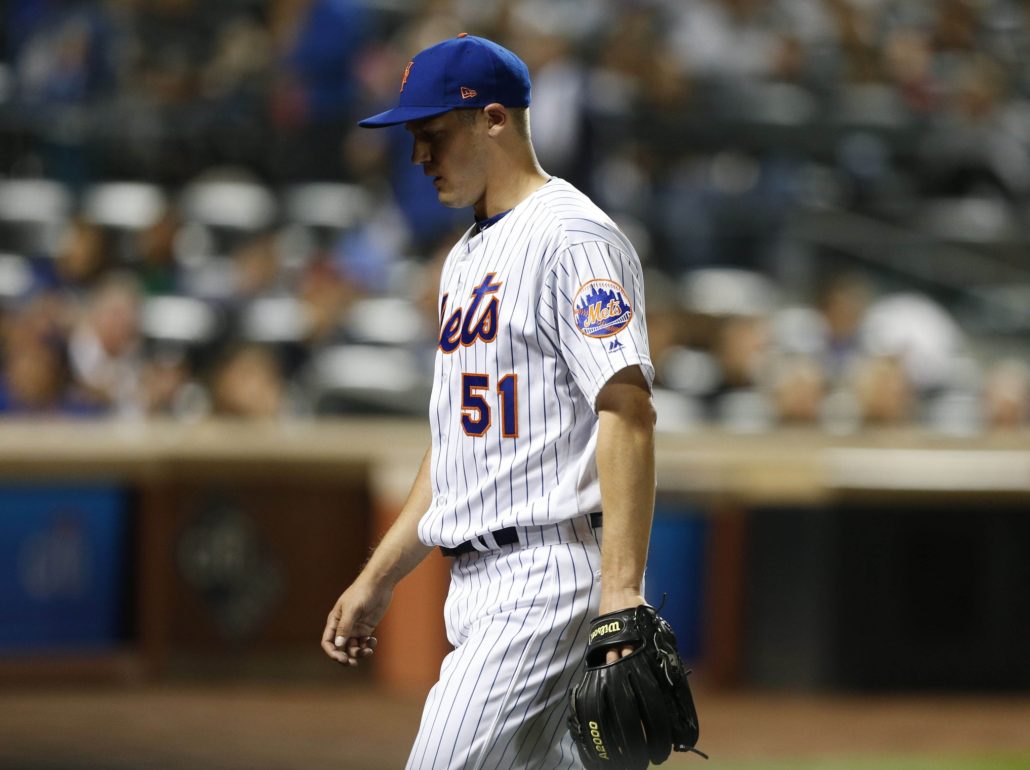
MMO: Did you start utilizing your change more after that?
Paul: You know, not as much as I should. As much as anyone will tell me, as much as Dan [Warthen] will tell me, as much as my dad will tell me, as much as Greg would say something. I didn’t use it quite as much as I probably should this year. I’ve been trying to throw it a little bit, but a lot of it is it is my third best pitch and as a reliever sometimes you get nervous to get beat with your third-best pitch. Then sometimes I felt like, Why am I trying to work on things when I’m in a major league game? My goal is to get people out.
At the same time, the only way to get confidence in it is to throw it. It’s a catch-22 that I need to get over and I think that’s something over the off-season I’m going to try and be mentally ready when I come into the season to utilize it as a weapon that maybe I didn’t last year.
MMO: When you look back on the 2017 season, what moment(s) stand out for you personally?
Paul: The most important game was the first week I got called back up. The starter [Adam Wilk] didn’t get out of the fourth inning and I had to come in against the Marlins. I went 3 1/3 and we were losing by a ton, it wasn’t necessarily a close game. I threw really well and their lineup is so underrated and ridiculous, that if they were a big market team everyone would realize how good they are.
I kind of took a step back at the end of the day and looked at it and I was like, I pitched really well against, I would say, one of the better lineups in baseball. I threw my regular pitches; I didn’t have to be perfect. I threw like Paul Sewald in Triple-A, so I think I can pitch here.
It was the first time that I got a lot of confidence that I was ready and I could pitch in the major leagues. It was really the first time that I got a ton of confidence and from there I kind of knew that I can pitch here. You just have to make good pitches and go out there and don’t try to be perfect. You’re good enough, just relax.
It kind of gave me the ability to take a breath and not feel pressure about it.
MMO: Were they any specific veterans that took you under their wing in the majors?
Paul: At the time we had a lot of veterans in the beginning of the year. Jerry Blevins and I started to be catch partners and it was good to get to throw with him and talk with him a ton. Being a bullpen guy that’s had a ton of success in the big leagues, it was good to sit there and just watch him and watch how he does things and how he carries himself and how he gets ready for games. I would love to have a career similar to his, it would be great. Especially since he plays the same position as me, it’s easy for me to kind of watch it.
MMO: Were there any rookie rituals that you had to be a part of during the year?
Paul: Not a ton. We do a couple of fun things like singing and karaoke and stuff like on the bus. You get in so much trouble now with rookie hazing and rookie anything that they really didn’t give me too much trouble. Occasionally, you have to get somebody water because you’re the young guy, but it really isn’t that big of a deal anymore.
I wish we could do a little more of the rookie hazing, I enjoyed it when I was in college. You know freshmen have to do it. Then when you get a little older you get to tell them to do it so it’s kind of fun. But at this point, you can’t really do it as much.
MMO: You’re childhood friends with Kris Bryant. Do you both keep in touch during the season and off-season?
Paul: Actually just got done playing golf with him today. We get to see each other quite a few times. Play some golf, occasionally go out to dinner, whatever it is. Last year I went to his wedding, this year he’s going to come to mine. It’s good to see him every once in a while.
His brother and I were on our very first Little League teams together, so I’ve known Kris since he was four. We were in the same Little League, grew up in the same area, and then he followed me to [the University of] San Diego which was pretty cool.
There are a few really good baseball players from Vegas that are kind of showing everybody that the city has a decent baseball rep, and it’s pretty cool. He and Bryce [Harper] have really put us on the map, it’s fun.
MMO: You got to face him once this year, right?
Paul: I got him to ground out to short. He had something to say about his drive today, so I reminded him that he’s 0-for-1 against me. So if he ever wants to pop off I still have that in my back pocket (laughs).
MMO: With the departures of Terry Collins and Dan Warthen from their respective roles, what did both men mean to you in your first big league season?
Paul: I thought they were both great. I felt like sometimes they got a little bit of a bad rap because with all the injuries we had; it was just difficult for everybody. From the front office to Terry to Dan. When you don’t have your horses on the team it’s difficult. Everyone watched the games and everyone knows what happened, but we had a disappointing season and so I’m disappointed that’s how they went out because they had so much success with us. But I really enjoyed working with both of them.
I love Dan and I appreciate everything he did for me, kind of easing me into hopefully a long major league career. I felt like he gave me a lot of things to think about, work on, and focus on coming into next spring. Just ultimately getting better every single season as the ultimate goal. He’s given me a lot of confidence that I feel like I can have a substantial major league career.
It was good to work with both of them and I’m definitely disappointed to see them go. I’m excited for the Mickey Callaway regime and I’m excited to work with him. Obviously he’s had a ton of success with the Indians pitching staff. Corey Kluber’s stuff is obviously gross but there’s a bunch of guys that have gotten better since they’ve been in the big leagues with him, and I think a lot of guys on our team can too.
MMO: What’s a typical offseason look like for Paul Sewald?
Paul: Going to start to work out, to keep the strength that we’re hoping to get. It was a long year so I realized how important the strength and conditioning aspect is. I’m going to start and get into the gym to make sure my body can handle not just September, but hopefully next year some October baseball. I’ll keep that in mind and going to try and make sure that my body is in peak condition and ready to rock and roll.
When it comes down to pitching, I had a decent season. Could I have pitched better? Yes. So what do I need to do to get better? I need to throw more strikes and I need to throw more quality strikes. Having a third pitch allows me to get different looks. So my fastball needs to be spotted a little bit better and, ultimately, if it’s not, then I can come back with a changeup. The slider needs to be toned a little bit to be a little sharper and a little bit better.
Ultimately, it’s nothing crazy; I just need to get a little bit better and make more quality pitches. It’s good that I don’t feel like I have to make a major overhaul, just get a little bit better.
MMO: Can’t thank you enough for the time today, Paul. All the best this off-season.
Paul: Absolutely! Appreciate it and excited to have an off-season to regroup and looking forward to being out in St. Lucie in February and getting this 2018 season going!
Follow Paul on Twitter, @ItsPaulSewald


